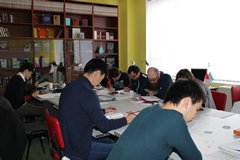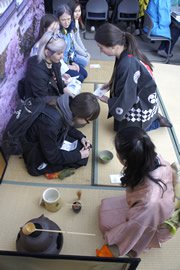A Wave of Japanese Culture Spreading in Kazakhstan
The Kazakhstan-Japan Center for Human Development
SEGAWA Ayako
The Republic of Kazakhstan in Central Asia is perhaps a country largely unfamiliar with Japanese people. There are, in fact, only 120 Japanese residents, including dependent children, so one will not likely encounter any Japanese people walking down the street. Despite this number, I am still surprised by people suddenly speaking to me in Japanese, for example when boarding a bus, with the Japanese words Konnichiwa (hello) or Arigatou (thank you). There are also several Sushi shops in town run by locals that are always full. Through this I can tell that Japanese culture is gradually spreading here.
And with EXPO 2017 scheduled to be held in the capital city of Astana this year, perhaps there will be more opportunities to hear about Kazakhstan in Japan as well.
Students Studying at The Japan-Kazakhstan Center for Human Development(KJC)
The number of students currently studying Japanese at KJC are roughly 100 in Almaty and 48 in branch office in Astana (including off-site courses). The students are having fun learning about the Japanese language and culture using the Marugoto: Japanese Language and Culture (hereinafter “Marugoto”) Japanese-language teaching materials. Many of the students developed an interest in Japan through Japanese subculture and Anime, motivating them to come to KJC to study Japanese. The majority are students and working adults, so the majority of classes take place between 6:30 and 8:00 PM in the evenings. Even though they might arrive at class somewhat tired from study or work, they soon regain their energy by using Japanese with their friends and learning new words.
Off-site Courses at the National Academic Library of Republic of Kazakhstan in Astana

Students studying Japanese enthusiastically at the off-site class at the library.
The Astana branch office offers an off-site class for the public on each Saturday. The class is held in a room of the National Academic Library of Republic of Kazakhstan in Astana, adjacent to the Baiterek Tower that symbolizes the city. The class is three hours long each session and uses the Marugoto textbook. While the majority of the students are working adults, there is only one primary school student (a 10-year-old boy) who hopes one day to study in Japan.
Cherry Blossom Festival

A tea sharing party during the Cherry Blossom Festival.
Its exciting to try macha for the first time
A Cherry Blossom Festival is held every year from mid through late April coinciding with the blooming of the cherry blossoms. The cherry trees located at KJC were planted by the then director after the Tohoku Earthquake in 2011 as a statement of hope for Japan’s recovery. We celebrate the blooming of the blossoms as the symbol and joy of Japan’s recovery. The festival itself in turn is gradually taking hold in the community, demonstrated by the several phone calls we received asking after the schedule when the blooming of the cherry blossoms was late this year.
During the festival, we hold workshops on Japanese culture including Shodo(calligraphy), Kendama games, Origami, Yukata dress, and Japanese style bookmarks, as well as mini-lessons in Japanese. One activity we tried for the first time this year was to lay out Tatami mats outdoors and served Matcha tea so attendees could enjoy tea under the cherry trees. The attendees gave varying opinions on the tea, which they drank for the first time, ranging from “delicious!” to “bitter!” Though it rained mid-event, it was a great success with over 100 people visiting in just two hours.
Karaoke Contest
Our third Karaoke Contest was held in February with the cooperation of the Japanese Society of Kazakhstan members who served as judges. The rules for the contest were to sing a Japanese song from memory without looking at the lyrics. Though the majority of the contestants were not students studying Japanese, they were fully prepared and memorized the Japanese for the songs. The contestants covered a wide range of ages this year, from primary school girls to older ladies, and a Mamemaki (bean throwing) event was held mid contest to celebrate the Setsubun ritual which just happened to fall on the same day. (Actually candy was substituted because of reasons that made bean throwing unfeasible.) Meanwhile, the winners of the contest also sang as entertainment at the Japanese Speech Contest in Kazakhstan.
The Japan Club
The Japan Club celebrated its second anniversary this year. The Japan Club is a group of students and former students who gather on Friday nights to hold Japan themed events. Accordingly, we celebrated the Kazakh New Year, called Nowruz, along with the Club’s 2nd anniversary, on March 17.
Nowruz is a very important festival for the people of Kazakhstan. The club members celebrated Nowruz together by preparing Nowruz-Koje, a milk-based porridge containing seven types of grains, and Bawïrsaq, a traditional fried bread from Central Asia. For the Bawïrsaq, we held a cooking class for Japanese guests and cooked the bread together. During birthday party, club members celebrated by singing the birthday song from Cheburashka in Japanese.
- What We Do Top
- Arts and Cultural Exchange [Culture]
- Japanese-Language Education Overseas [Language]
- Japanese-Language Education Overseas [Language] Top
- Learn Japanese-language
- Teach Japanese-language
- Take Japanese-Language Test
- Know about Japanese-language education abroad
- The Japanese-Language Institute, Urawa
- The Japanese-Language Institute, Kansai
- Japanese-Language Programs for Foreign Specified Skilled Worker Candidates
- Japanese Language Education for Japanese Children Resident Overseas and for the Descendants of Migrants
- Archives
- Japanese Studies and Global Partnerships [Dialogue]
- JF digital collection
- Other Programs / Programs to Commemorate Exchange Year
- Awards and Prizes
- Publications
